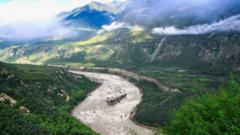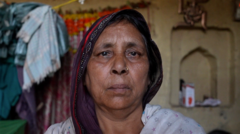China's ambitious plans to construct the Yarlung Tsangpo hydropower dam in Tibet have ignited a fierce debate over the potential displacement of local communities and environmental harm, especially in neighboring India and Bangladesh.
China's Mega Hydropower Dam in Tibet Sparks Controversy

China's Mega Hydropower Dam in Tibet Sparks Controversy
Construction begins on world's largest hydropower dam, raising environmental and human rights concerns.
China has officially launched the construction of what is set to become the world's largest hydropower dam on the Yarlung Tsangpo river in Tibet, raising substantial concerns among local communities and environmental advocates. The new dam is expected to generate three times more energy than the renowned Three Gorges Dam, currently the largest hydropower facility globally.
Chinese state media assures that the project emphasizes ecological preservation and will foster regional prosperity while assisting Beijing's climate goals. Contrarily, human rights organizations and other observers express deep apprehension regarding the far-reaching repercussions of the dam, which was first proposed in 2020. Concerns revolve around the potential displacement of locals and significant alteration of Tibet's irreplaceable natural landscape.
Activists assert that the ongoing dam constructions in Tibet epitomize the Chinese government's exploitation of Tibetan resources and communities. In recent months, extensive crackdowns against protests have been reported, leading to violence and arrests among dissenters opposing other hydropower initiatives like the Gangtuo dam, which threatens to displace numerous villages and inundate ancient monastic sites.
Chinese authorities maintain that the Yarlung Tsangpo project will not entail considerable ecological ramifications, although there is no transparency regarding the number of people likely to be displaced—anywhere from the 1.4 million displaced during the Three Gorges Dam project.
The sheer scale of this dam will necessitate the drilling of four extensive tunnels through the Namcha Barwa mountain, a project which risks altering the river's course. Experts have expressed concerns that this could amplify China's control over the vital trans-boundary Yarlung Tsangpo, which flows into India's Arunachal Pradesh and Assam states and further into Bangladesh.
As geopolitical tensions mount, India is reportedly considering developing its own substantial hydropower project to counteract the potential negative effects posed by China's dam constructions. Following the announcement of the Yarlung Tsangpo project, India's government has shown intentions to counterbalance China's influence over the river systems.
Inherent challenges await the execution of this colossal endeavor, as Tibet’s unique topography includes the world's deepest canyon, with parts of the river descending 2,000 meters over short distances. Geological assessments have raised alarms that extensive construction operations could heighten the risk of landslides in the already earthquake-prone region.
Estimated to cost up to a trillion yuan (around $127 billion), the Yarlung Tsangpo dam epitomizes both China's ambitious renewable energy aspirations and the environmental and ethical dilemmas entangled with such large-scale infrastructural projects.























